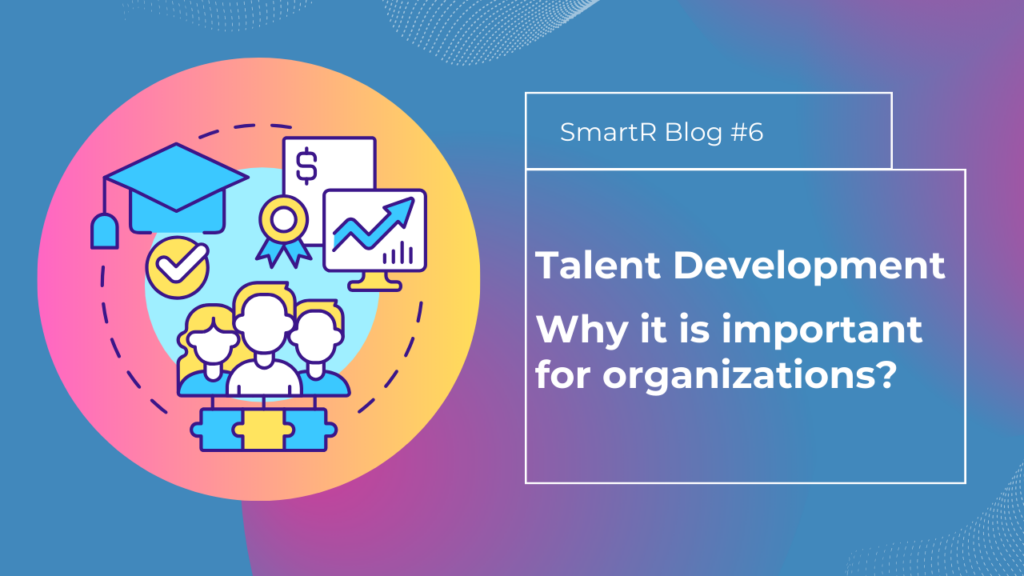In today’s rapidly evolving business landscape, placing a high priority on continuous talent development is essential. By fostering a culture of learning, organizations empower their employees with the skills necessary to thrive amidst change, ensuring the future resilience of the business.
We’ve put together this ultimate guide to developing your talents in the company. We’ll take a deep dive into:
- What is Talent Development?
- Importance of Talent Development
- How can SmartR’s platform help in Talent Development
1. What is Talent Development?
Talent Development involves organizations investing in nurturing learning and enhancing their employees’ professional development. It includes regularly assessing employees’ strengths and weaknesses and actively engaging in programs that contribute to their skill sets.
Despite a growing number of companies investing in talent development, many still opt to fire employees instead of providing training. Karlyn Borysenko conducted a survey of 1,050 individuals who had been fired from their jobs, seeking to understand their experiences. The results uncovered surprising insights
- 75% of respondents claimed their manager never discussed concerns before firing them.
- 59% did not receive invitations for a performance review.
- 87% did not notice any signs of being fired.
- 20% of those being fired weren’t given a reason.

Therefore, Talent Development emerges as a crucial investment for organizations committed to fostering a culture of learning and employee growth. The stark contrast between companies embracing talent development initiatives and those resorting to employee termination without adequate communication or feedback is evident. This distinction underscores the crucial need for organizations to prioritize talent development over premature dismissals, emphasizing a proactive approach to employee growth and retention.
2. Advantages of Talent Development

While firing underperforming employees may be necessary in some situations, there are several reasons why investing in talent development is often considered a more strategic and beneficial approach:
Knowledge Retention
Existing employees have valuable institutional knowledge about the company, its processes, and its culture. Losing experienced staff can result in a loss of this knowledge, which can be challenging to replace.
Boost Employee Morale and Engagement:
Providing opportunities for learning and growth can boost employee morale and job satisfaction. Engaged employees are more likely to be productive and committed to their roles, contributing positively to the overall work environment.
Positive Organizational Culture
Nurturing talent reinforces a positive organizational culture where employees feel valued and supported. This can lead to a higher levels of employee loyalty and a stronger sense of commitment to the company. Investing in talent development also demonstrates a commitment to employee growth and is likely to contribute to a positive public image.
Employee Retention
Employees are more likely to stay with a company that invests in their professional development. This can lead to a more stable and experienced workforce, reducing turnover in the company and its associated costs.
Long-Term Success
Organizations that prioritize talent development are better positioned for long-term success. Continuously improving the skills and capabilities of the workforce ensures that the company remains competitive in the marketplace.
There are indeed instances whereby terminating an employees’ contract may be necessary but a comprehensive talent development strategy is often seen as a more sustainable and strategic approach to building a skilled, engaged, and loyal workforce. This approach aligns with the idea that investing in employees’ growth and well-being can lead to positive outcomes for both individuals and the organization as a whole.
3. How can SmartR’s platform help in Talent Development
The Talent Development function in SmartR’s platform aims to create personalized development plan for each employee based on their needs and the company’s goals.
Step 1: Create Training Programs, Courses or classes
Managers can create training programs, courses, or classes based on their organization’s needs.
Step 2: Deploy Training for their Employees
Training Managers can allocate courses to their employees based on the organization’s need and the employee’s weaknesses. Depending on the learning environment, managers can deploy training online or offline, with or without trainers.
Step 3: Track Employee’s Progress and KPIs
Managers can easily track the employee’s progress and training KPIs. With that, appropriate courses can be allocated to the employees based on their needs.
SmartR’s platform aims to create a blended learning experience, which empowers employees to take control of their professional development, with flexible and personalized learning options that cater to diverse learning styles.
Conclusion
In conclusion, prioritizing continuous talent development is crucial in today’s fast-paced business environment. While some organizations resort to premature dismissals, investing in talent development proves to be a strategic and sustainable approach. This approach brings advantages such as knowledge retention, increased employee morale, positive organizational culture, enhanced retention, and long-term success.
SmartR’s platform enables organizations to create personalized development plans, deploy training programs, and track progress seamlessly, empowering a culture of continuous learning and growth.
If you are interested to develop your talents with SmartR, do SIGN UP for a trial account today.

